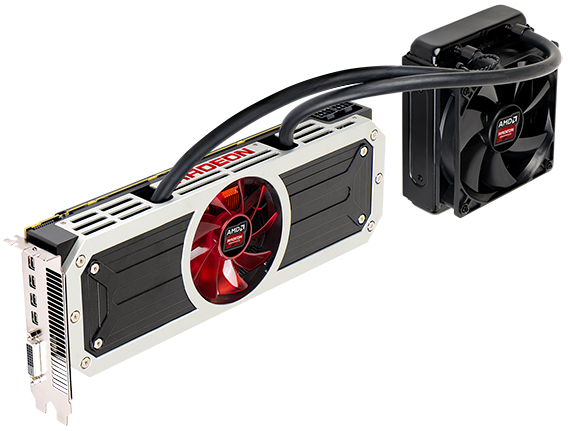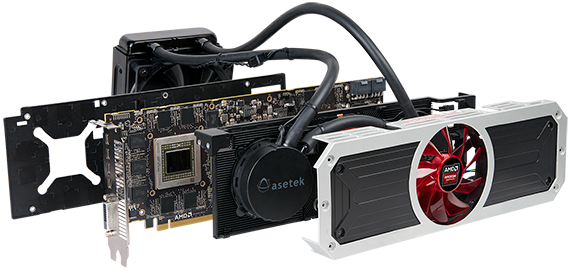 The graphics card market has been in a bit of a funk for the last couple of years. While the performance of the high end cards has improved, the amount of performance needed to play games at the typical 1920×1080 resolution is just fine in the budget to mid-range cards. So why does AMD end up announcing their new graphics card that is more than twice the cost of their previous board? Basically, AMD and NVIDIA are looking to target those users that are either using their PCs for high resolution gaming with 4K UltraHD displays or using multiple displays. Sure, the cards are also being used for heavy computing tasks as well such as scientific research and cryptocoin mining. The design of the Radeon R9 295X2 is both very different yet familiar at the same time…
The graphics card market has been in a bit of a funk for the last couple of years. While the performance of the high end cards has improved, the amount of performance needed to play games at the typical 1920×1080 resolution is just fine in the budget to mid-range cards. So why does AMD end up announcing their new graphics card that is more than twice the cost of their previous board? Basically, AMD and NVIDIA are looking to target those users that are either using their PCs for high resolution gaming with 4K UltraHD displays or using multiple displays. Sure, the cards are also being used for heavy computing tasks as well such as scientific research and cryptocoin mining. The design of the Radeon R9 295X2 is both very different yet familiar at the same time…
Two Radeon R9 290X In A Single Board
So the solution to the dual GPU setup is not that different from past products from AMD. Basically, they have taken two of the graphics processors in the Radeon R9 290X cards and put them on a single board in a CrossFire configuration. This means that it just takes up a single slot but it has some issues that required the massive redesign. The Radeon R9 290X cards pulled a lot of power which in term generates a fair amount of heat. Even a single R9 290X graphics card had trouble dissipating the heat with cooling fans that would spin up to very fast with corresponding noise. A number of OEM companies tried adjusting this with extra fans but putting two onto a single board poses extreme heat and power constraints.
The Performance
In terms of the 3D performance, the Radeon R9 295X2 performs pretty much on par with a pair of Radeon R9 290X graphics cards in a CrossFire configuration. This means that it is capable of playing modern games with high detail levels on 4K or UltraHD displays or across three 1080p displays using Eyefinity. In fact, the R9 295X2 actually outperformed the CrossFire R9 290X setups because it is better able to pull heat away from the GPU. This means it was less impacted by thermal throttling that reduces the clock speed and performance. This performance gap ranges from negligible to about ten percent depending upon tasks and ambient temperatures.
NVIDIA’s huge is still not fully launched at his point so it is hard to compare it to Radeon’s dual GPU card. It can be compared against two NVIDIA GeForce GTX 780 Ti cards in an SLI setup which is close to what the TITAN Z is expected to be. In most cases, the Radeon R9 295X2 is able to outperform but it is going to be very dependent upon the game engine. Some still prefer the NVIDIA architecture where the SLI setup has a slight edge.
We Need More Power
In order to achieve such high performance, the Radeon R9 295X2 requires a huge amount of power. This isn’t particularly surprising given that it is essentially two high powered graphics cards put together. After all, many of the R9 290X cards alone requested power supplies of up to 750 Watts. The difference here is that for this card, it needs a power supply that features 28 amps worth of power for each of the PCI-Express 8-pin power connectors that feed the card. This is something that you will likely only find in very high end power supplies of nearly a kilowatt and when the cords are tied into specific connectors if it is a modular design. So if you are interested in getting a R9 295X2, you better check to make sure your power supply will be sufficient.
The Pricing Problem
Expected retail pricing for the Radeon R9 295X2 card us expected to be roughly $1500-$1600. When compared to the announced NVIDIA GTX TITAN Z card with its $3000, it is a bargain. The issue comes more from this dual GPU card having to compete with two individual cards. The current street pricing for a Radeon R9 290X is around $600-$700. This means that you can get nearly the same performance from a CrossFire setup of two R9 290X cards for several hundred less. In terms of the NVIDIA alternative of two GTX 780 Ti cards in an SLI setup, it would be roughly the same cost as they are selling around $700 to $750.
Of course, running two graphics cards instead of one means you need to have a motherboard that supports CrossFire or SLI with two PCI-Express graphics cards slots, not to mention the room to fit both of the cards and the required power supply to drive them all. Even if these two solutions are more affordable than the single Radeon R9 295X2, the liquid cooling solution offers a huge improvement in the heat and noise levels from the system. This can be a big bonus for those people who want low noise systems or are trying to overclock their processors and want to limit the heat inside of the system.
For more detailed benchmark numbers, check out the follow sites:

